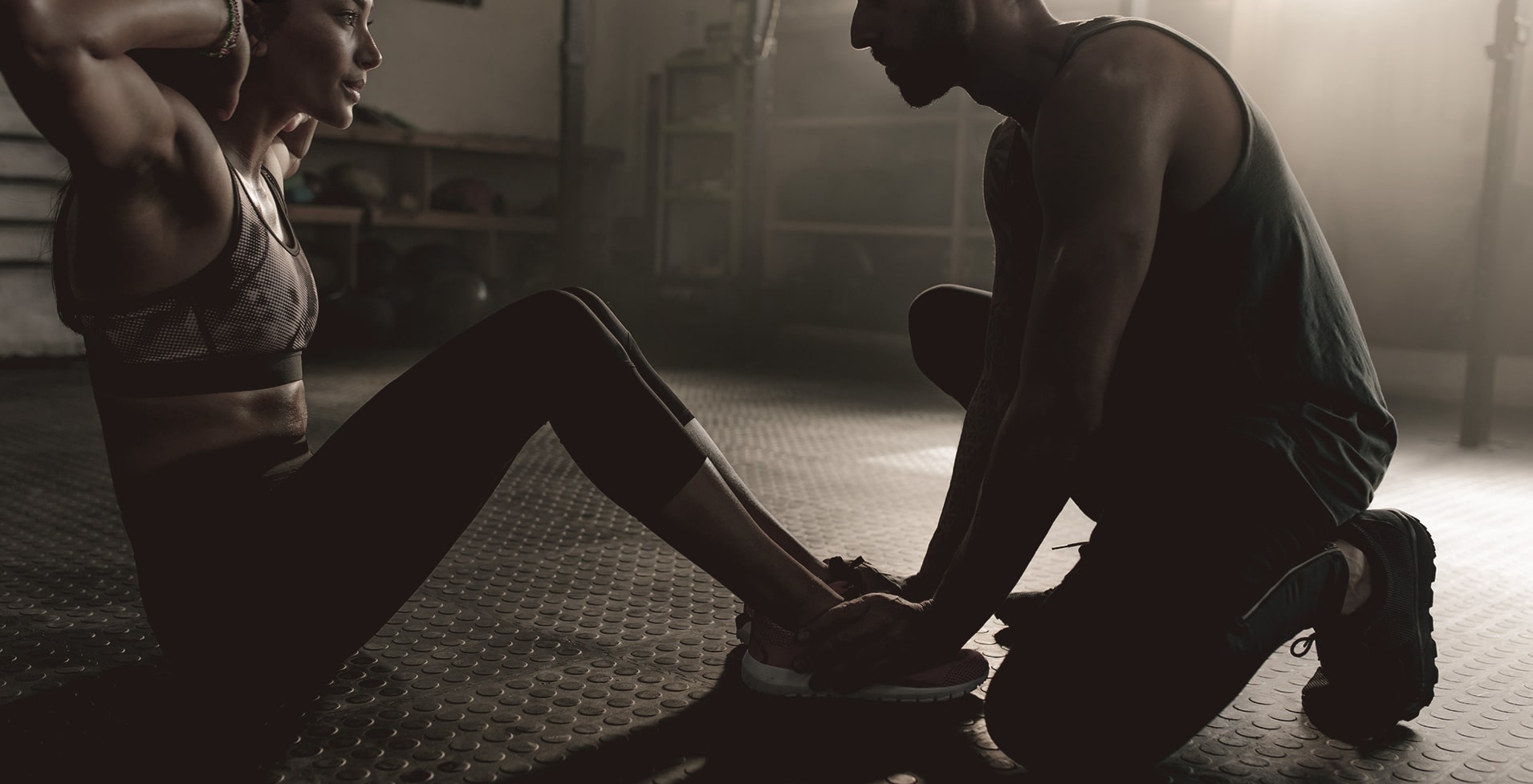Comparing the trap bar deadlift vs squat, there are many differences between these lower body exercises to be aware of in the gym.
Whether it be form or technique, the trap bar deadlift and the barbell back squat are very different. Even so, these two lower body exercises are a staple in many fitness enthusiasts’ routines for a reason—their powerful benefits!
We don’t want you to miss out on these staple exercises and their heavily researched benefits. That’s why we will break down the differences between the trap bar deadlift and squats so you can see why these exercises should be prioritized in your workout routine ASAP!
Table of Contents
Trap Bar Deadlift vs Squat–The Differences
The trap bar deadlift vs squat–what are the differences between these two hardcore resistance exercises? From joints worked to equipment used, let’s dive in below!
Joints Worked & Ranges of Motion
There are two grip placement options for lifters for the trap bar deadlift: low and high handlebars. The low handlebar option creates a deeper range of motion for lifters, meaning more significant hip and knee flexion. There will be less substantial knee and hip flexion with the high handlebar grip placement than with the low handlebar grip placement because of the reduced range of motion required.
Compared to trap bar deadlifts, the barbell squat requires the ankle, knee, and hip joints to perform the movement. The flexion of these joints to enter the squat position is then followed by extension when returning to an upright standing position.
Equipment Used
The trap bar deadlift and the barbell squat require different equipment to perform the exercise.
A bar squat requires a squat rack and a barbell. The squat rack is essential as it helps the lifter set up to perform the barbell squat. There are adjustable attachments for different heights for lifters to customize their lift. These attachments on the squat rack hold the barbell for the lifter to add on weight plates and pick up the barbell to perform repetitions.
For trap bar deadlifts, a hex bar is required. The bar is specially designed in a hexagonal shape and does not require any squat racks or additional equipment other than weight plates to perform repetitions.
Muscles Worked
The trap bar deadlift and squats also work different muscle groups. Knowing which muscles are engaged throughout an exercise is crucial to ensuring that your workout program meets your goals.
The trap bar deadlift and the barbell squat both engage the lower body muscles. However, other muscles, like the posterior chain, are utilized throughout these movement patterns. Here are some of the muscles used in the barbell back squat and the trap bar deadlift.
Muscles Worked – Trap Bar Deadlifts
- Hamstrings
- Gluteal
- Quadriceps
- Spinal erectors
- Adductors
- Abductors
- Abdominal
- Gastrocnemius
- Latissimus Dorsi
- Forearm
- Rhomboideus
Muscles Worked – Barbell Back Squat
- Hamstrings
- Calves
- Abdominals
- Erector spinae
- Gluteal
- Quadriceps
- Biceps
- Triceps
- Forearms
- Traps
- Abductors
- Adductors
- Rhomboids
The trap bar deadlift and the barbell square are great lower-body exercises that can fluidly act as full-body exercises thanks to their capabilities to engage numerous muscle groups throughout the body.
Grip Position
The grip positions for trap bar deadlifts and barbell squats are very different.
For the trap bar deadlift, the hexagonal shape of the bar includes two neutral grip options, the low and high handlebars. This design is great for beginners who are learning how to maintain good form, as the neutral grip position will prevent the bar from rolling out of the hands. This aids the lifter in maintaining grip strength.
The barbell squat places the barbell on the upper back by creating a shelf with the upper back muscles. This is accomplished by squeezing the shoulder blades together and positioning the hands near the shoulders on the bar for the lift. Two grips are necessary for holding the barbell for the back squat–the thumbless and overhand grip.
Equipment Limitations
There are equipment limitations to be made aware of regarding the barbell back squat and trap bar deadlift.
A straight barbell is standard gym equipment in commercial gyms. Not so much in apartment gyms. For individuals who don’t have access to a commercial gym, this can be extremely limiting.
Most squat racks have a design that allows for safety bars to be set up, so a spotter is optional for lifters who are lifting solo. This is ideal for individuals who may be uncomfortable asking for a spotter or if there’s no one around to ask. It is not plausible to complete the barbell squat without a squat rack as there are major safety concerns for setting up for the lift without one.
There is a 50/50 chance you’ll find a hex bar at your local commercial gym. The equipment has progressively gotten more popular, so it is more common to see it than not, but not all gyms have joined the trap bar party. Unfortunately, this can be quite limiting for gym goers paying membership fees for diverse equipment options and who wish to try their hand at trap bar deadlifts and other variations.
Form & Movement Pattern
The form and movement pattern between trap bar deadlifts and back squats differ significantly. They are considered a natural movement, utilizing knee extension and hip flexion.
There are a variety of squat variations, many of which alter hip-width stance or weight load placement, like the front rack positioning for a front squat. No matter the variation, the movement pattern of a squat involves bending at the knees and dropping the butt down. A good movement cue for lifters is to think of sitting down on an invisible chair behind you.
One of the top types of deadlifts, the trap bar deadlift has a more upright torso for less back stress compared to the conventional deadlift. It incorporates a hinge movement rather than a squatting movement. A form cue for the hinge movement of the deadlift is to push the hips back or “close the door” with your butt.
How to Perform a Hex Bar Deadlift
Comparing the barbell squat and hex bar deadlift, the trap bar deadlift has more hip hinge movement. The barbell squat has greater knee flexion than trap bar deadlifts, having an almost half squat position for the hinge movement.
The trap bar deadlift is a conventional deadlift variation with dissimilarities to be made aware of. Understanding the difference between conventional deadlifts, barbell squats, and trap bar deadlifts is vital for practicing quality technique and form to prevent injury and receive the benefits of these compound resistance movements.
How to Perform a Trap Bar Deadlift:
- Stand in the center of the trap bar with feet hip-width apart.
- Maintain a body position of a neutral spine with arms straight, a slight bend in the knees, and core engaged.
- Push your hips back to grab the trap bar handles with palms facing your sides.
- Drive your feet into the ground and through your hips as you return to a standing position with the trap bar in tow.
- Hinge at the hips to lower down until the plates on either side of the hex bar tap the ground.
- This is one repetition.
How to Perform a Back Squat
The squat movement pattern is universal no matter the variation of barbell squats, front squats, or otherwise. The only difference in the variations is the way the weight is carried. For example, equipment using a kettlebell, barbell, dumbbell, and so on can be held on the shoulders, in a goblet-hold, or on the back.
A common technique error with squats is hyperextending at the bottom portion of the movement. Hyperextension of the low back during a squat looks like a “butt wink” or pushing the butt out excessively during a squat, which can cause unnecessary stress to the lower back. Sometimes hyperextension is a mobility concern in the ankles, another reason why incorporating mobility training into your routine is highly advised for everyone.
How to Perform a Barbell Back Squat:
- Set up the barbell in the squat rack so the barbell is resting just below shoulder height.
- Move underneath the bar with feet shoulder-width apart.
- Squeeze the shoulder blades together to create a “shelf.” The bar should rest on the muscles of the upper back.
- Clasp the bar, positioning the hands on the bar comfortably close to the shoulders.
- Tense the lower and upper body, driving up to take the barbell off the rack.
- Back up away from the rack, aligning your feet into the correct position to squat.
- Maintaining a neutral upper body position, bend at the knees to lower down into the bottom position of the barbell squat.
- Thighs should be parallel with the floor with no hyperextension of the lower back.
- Drive the feet through the floor to return to the starting position.
- This is one repetition.
Squat Pros and Cons
The barbell back squat is used in powerlifting competitions, like the sumo barbell deadlift and the conventional barbell deadlift, to demonstrate an athlete’s strength in lifting impressive weight loads. The front squat is a squat variation used in other competitions, such as CrossFit or Olympic lifting competitions.
There are many benefits associated with barbell back squats as the exercise engages multiple muscle groups in the lower and upper body. It is commonly used for building strength and muscular hypertrophy to increase muscle mass.
Pros:
- Great full-body exercise for strengthening the body in natural movements
- Numerous squat variations to try with different equipment (e.g., TRX squat, dumbbell squat, front squat)
- Strengthens the core better than isolated ab exercises
- Improves lower body strength
- Boosts hormone production
- Improves knee joint strength
Cons:
- Higher injury risk (e.g., back, shoulders) when performing the exercise
- May require a spotter with heavier weights
- Requires a squat rack

Trap Bar Deadlift Pros and Cons
The trap bar deadlift is a highly specific deadlift variation that has been thoroughly studied and shown to have outstanding benefits for lifters. Unfortunately, even with the benefits, trap bar deadlifts have cons, like any exercise, such as not being an approved lift for competitions for powerlifting or CrossFit.
Pros:
- Less stress on the lumbar spine
- Effective exercise for engaging the posterior chain
- Easier to lift heavy weights
- Effectively incorporates the quad muscles
- Easy for beginners to learn
- Enhances velocity, power, and force
- Great for athletes looking to upgrade athletic performance
Cons:
- Less emphasis on the lower back and hamstrings than in conventional deadlifts
- Not all gyms have the trap bar equipment
- Less variations for grip and customization
- Not used in powerlifting competitions

Suitable Alternative to Barbell Back Squats
Many alternatives to barbell back squats follow the squat movement pattern. Whether it be the need to lift much lighter weights or heavier weights or because you do not have access to a barbell and squat rack, there are numerous squat variations like the TRX squat and the body weight squat for lighter weight alternatives.
Other squat alternatives to consider:
- Leg press
- Step-ups
- Lunges
- Bulgarian split squats
- Deadlifts
Frequently Asked Questions (FAQ)
Can Trap Bar Deadlifts Replace Squats?
We don’t recommend replacing squats with trap bar deadlifts as the movement pattern is different. The hip hinge and squat movement patterns engage the hips and other joints in separate ways to improve mobility and prevent injury.
Both exercises are beneficial in different ways. If you wish to remove barbell squats from your routine, we recommend choosing an alternative, like lunges or the leg press, to prioritize the movement pattern for its benefits.
Can a Trap Bar Be Used for Squats?
Yes! The trap bar can be used for squats and deadlift variations like the Romanian deadlift. If you don’t have access to a barbell or heavy dumbbells, the trap bar squat is a great exercise to add to your workout.
Are Trap Bar Deadlifts Better Than Squats?
Though the exercise is beneficial, trap bar deadlifts are not better than squats. Squats are technical, requiring full-body engagement to perform. Both exercises have their benefits, so incorporating each is recommended.
Final Thoughts
In this article, we broke down the trap bar deadlift vs squat, including the differences, pros, cons, and benefits of both exercises.
Trap bar deadlifts are an all-around, beginner-friendly exercise that is great for athletes, everyday gym goers, and just about everyone. The barbell squat is a full-body resistance movement that requires more experience or assistance to prioritize proper form to avoid injury. Each has pros and cons, but we recommend adding both to your workout regimen for their powerful health and fitness benefits!














